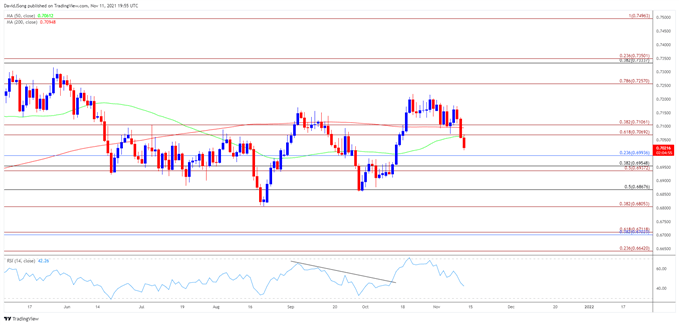New Zealand Dollar Talking PointsNZD/USD trades to a fresh monthly low (0.7012) on the back of US Dollar strength, and the exchange rate may conti
New Zealand Dollar Talking Points
NZD/USD trades to a fresh monthly low (0.7012) on the back of US Dollar strength, and the exchange rate may continue to depreciation over the coming days as it fails to defend the opening range for November.
NZD/USD Remains Vulnerable Amid Failure to Defend November Opening Range
NZD/USD extends the series of lower highs and lows from earlier this week after giving back the initial reaction to the larger-than-expected uptick in the US Consumer Price Index (CPI), and it seems as though the stickiness in inflation may generate increased participation in the US Dollar as it puts pressure on the Federal Reserve to implement higher interest rates sooner rather than later.
It remains to be seen if the Federal Open Market Committee (FOMC) will respond to the fresh data prints as San Francisco President Mary Daly, a 2021 voting-member, argues that “it would be premature to start changing our
calculations about raising rates,” with the official going onto say that “uncertainty requires us to wait and watch with vigilance” during an interview with Bloomberg News.
The comments suggests the FOMC will stick to its exit strategy as the central bank continues to brace for a transitory rise in inflation, but signs of stronger price growth may keep the US Dollar afloat ahead of the next FOMC interest rate decision on December 15 as the central bank is slated to update the Summary of Economic Projections (SEP).
Until then, NZD/USD may continue to depreciate as it reveres course following the failed attempt to test the October high (0.7219), and a further decline in the exchange rate may continue to alleviate the tilt in retail sentiment like the behavior seen earlier this year.

The IG Client Sentiment report shows 43.05% of traders are currently net-long NZD/USD, with the ratio of traders short to long standing at 1.32 to 1.
The number of traders net-long is 14.54% higher than yesterday and 25.00% higher from last week, while the number of traders net-short is 0.29% lower than yesterday and 12.24% lower from last week. The rise in net-long interest has helped to alleviate the crowding behavior as only 35.83% of traders were net-long NZD/USD last week, while the decline in net-short position comes as the exchange rate pushes to a fresh monthly low (0.7012).
With that said, NZD/USD may face a further decline over the coming days as it extends the series of lower highs and lows from earlier this week, and the advance from the October low (0.6877) may continue to unravel as the exchange rate fails to defend the opening range for November.
NZD/USD Rate Daily Chart

Source: Trading View
- Keep in mind, a head-and-shoulders formation materialized in the first quarter of 2021 as NZD/USD slipped below the 50-Day SMA (0.7061) for the first time since November, with the exchange rate pushing below the 200-Day SMA (0.7095) for the first time since June 2020 to trade to a fresh yearly low (0.6805) in August.
- Nevertheless, NZD/USD reversed course ahead of the November 2020 low (0.6589) amid the failed attempt to close below the 0.6810 (38.2% expansion) region, with the exchange rate taking out the September high (0.7170) during the previous month as the Relative Strength Index (RSI) pushed above 70 during the same period.
- However, NZD/USD is back under pressure after failing to test the October high (0.7219), with the break/close below the Fibonacci overlap around 0.7070 (61.8% expansion) to 0.7110 (38.2% expansion) bringing the 0.6990 (23.6% retracement) region on the radar as the exchange rate fails to defend the opening range for November.
- Next area of interest comes in around 0.6940 (50% expansion) to 0.6960 (38.2% retracement) region followed by the 0.6870 (50% retracement) area.
— Written by David Song, Currency Strategist
Follow me on Twitter at @DavidJSong
element inside the
element. This is probably not what you meant to do!Load your application’s JavaScript bundle inside the element instead.
www.dailyfx.com